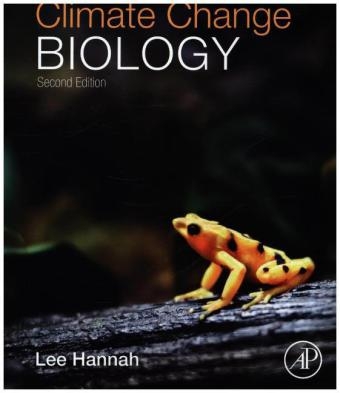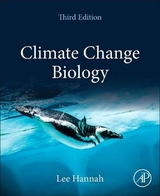
Climate Change Biology
Academic Press Inc (Verlag)
978-0-12-420218-4 (ISBN)
- Titel erscheint in neuer Auflage
- Artikel merken
Lee Hannah is Senior Researcher in Climate Change Biology at the Betty and Gordon Moore Center for Science and Oceans at Conservation International (CI). Tracking with his interest in the role of climate change in conservation planning and methods of corridor design, he heads CI’s efforts to develop conservation responses to climate change. He works collaboratively with the Bren School at UC Santa Barbara to model climate impacts on species in California, and with the National Botanical Institute in Cape Town, South Africa to model biotic change resulting from global warming in biodiversity hot spots in that region. He has written on the global extent of wilderness and the role of communities in the management of protected areas.
Acknowledgments
Section 1. Introduction
Chapter 1. A New Discipline: Climate Change Biology
A Greenhouse Planet
Boundaries of Life
Shifting Interactions
Chemistry of Change
Linkages Back to Climate
Climate Change Biology
Chapter 2. The Climate System and Climate Change
The Climate System
Evolution of the Earth’s Climate
Natural Drivers of Change
Major Features of Present Climate
Stable States of the System
Human-Driven Change: Rising CO2
Rapid Climate Change
The Velocity of Climate Change
Modeling the Climate System
Regional Climate Models
Commonly Used GCMs
Emissions Pathways
GCM Outputs
Biological Assessments with Downscaled Data
Section 2. The Impacts of Human Induced Climate Change
Chapter 3. Species Range Shifts
First Sign of Change: Coral Bleaching
First Changes on Land
Mounting Evidence of Range Shifts
Patterns within the Patterns
Extinctions
Freshwater Changes
Pests and Pathogens
Chapter 4. Phenology: Changes in Timing of Biological Events Due to Climate Change
Arrival of Spring
Freshwater Systems
Spring Ahead, Fall Behind
Tropical Forest Phenology
Marine Systems
Mechanisms: Temperature and Photoperiod
Life-Cycles of Insect Herbivores
Timing Mismatches Between Species
Chapter 5. Ecosystem Change
Tropical Ecosystem Changes
Cloud Forests
Temperate Ecosystem Change
High Mountain Ecosystems
Glacier and Snowpack-Dependent Ecosystems
Polar and Marine Systems
Polar Food Webs: Changes in the Southern Ocean
Tropical Marine Systems
Pelagic Marine Systems
Ocean Acidification
Ecosystem Feedbacks to Climate System
Section 3. Lessons from the Past
Chapter 6. Past Terrestrial Response
Scope of Change
The Earth Moves
Climate Runs Through It
Fast and Far: The Record of the Ice Ages
Ice Racing in North America and Europe
Out of Land: The Southern Temperate Response
North Meets South
Rapid Change: The Younger Dryas
Tropical Responses
Milankovitch Forcing in the Biological Record
Lessons of Past Change
Chapter 7. Past Marine Ecosystem Changes
Effects of Temperature Change
Effects of Sea-Level Change
Changes in Ocean Circulation
Changes in Ocean Chemistry
Chapter 8. Past Freshwater Changes
Lakes as Windows to Past Climate
Types of Freshwater Alteration with Climate
Freshwater Biotas, Habitats, and Food Chains
Deep Time: Pace of Evolution and Species Accumulation
Recent-Time (Tertiary and Pleistocene) Records of Change
Fast Forward
Chapter 9. Extinctions
The Five Major Mass Extinctions
Causes of Extinction Events
Climate as the Common Factor in Major Extinctions
Impacts and Climate
Does Climate Change Always Cause Extinction?
Climate and Extinctions in Deep Time
The Past 100 Million Years
The Past 2 Million Years: Extinction at the Dawn of the Ice Ages and the Pleistocene Extinctions
The Missing Ice Age Extinctions
Patterns in the Losses
Section 4. Looking to the Future
Chapter 10. Insights from Experimentation
Theory
Laboratory and Greenhouse Experiments
Field Experiments
Results of Whole-Vegetation Experiments
Results of Field CO2 Experiments
Freshwater Experiments
Arctic Experiments
Chapter 11. Modeling Species and Ecosystem Response
Types of Models
Dynamic Global Vegetation Models
Species Distribution Models
Gap Models
Modeling Aquatic Systems
Earth System Models
Chapter 12. Estimating Extinction Risk from Climate Change
Evidence from the Past
Estimates from Species Distribution Modeling
Species–Area Relationship
A Question of Dispersal
The Problem with Endemics
Checking the Estimates
Not Just about Polar Bears Anymore
Are a Million Species at Risk?
Why the Future May Not Be Like the Past
Chapter 13. Ecosystem Services
Food Provision—Marine Fisheries
Water Provisioning
Carbon Sequestration
Fire
Tourism
Ecosystem-Based Adaptation
Coastal Protection
Water Supply
Food Production
Disaster Risk Reduction
Section 5. Implications for Conservation
Chapter 14. Adaptation of Conservation Strategies
Early Concepts of Protected Areas and Climate Change
Protected Area Planning
Planning for Persistence
Resistance and Resilience
Protected-Area Management
Marine Protected Areas
Protected Areas for Climate Change
Chapter 15. Connectivity and Landscape Management
Area-Demanding Species
Migratory Species
Species Range Shifts
Planning for Connectivity
Managing Connectivity in Human-Dominated Landscapes
Planning for Climate “Blowback
Regional Coordination
Monitoring
Chapter 16. Species Management
Threatened Species
Climate Change Impacts on Threatened Species
Species Threatened by Climate Change
Assessing Species Threatened by Climate Change
An Iconic Example
Managing Species Threatened by Climate Change
Resources for the Job
Section 6. Finding Solutions: International Policy and Action
Chapter 17. International Climate Policy
United Nations Framework Convention on Climate Change
Intergovernmental Panel on Climate Change
Carbon Markets
Reduced Emissions from Deforestation and Degradation
Adaptation
Why Doesn’t It Work?
Chapter 18. Mitigation: Reducing Greenhouse Gas Emissions, Sinks, and Solutions
Stabilizing Atmospheric Greenhouse Gas Concentrations
Practical Steps for the Next 50years
Energy Efficiency
Renewable Energy Sources
Nuclear Power
The End of Oil
Clean Coal?
Tar Sands, Oil Shales and Fracking
Geoengineering
Extinction Risk from Climate Change Solutions
Land Use Requirements of Alternate Energy
Short-term Wedges and Long-term Pathways
Chapter 19. Carbon Sinks and Sources
The Carbon Cycle
Slow Carbon
Fast Carbon
Ocean Carbon Cycle
Terrestrial Carbon Cycle
Human Influence on the Carbon Cycle
Recent Trends in Terrestrial Sources and Sinks
Carbon Cycle and Carbon Sequestration
Getting CO2 Back
Chapter 20. Assessing Risks, Designing Solutions
Impacts, Risks, and Adaptation
The Assessment Process
Domain and Grain
Biological Assessment
Stand-Alone Biological Assessment
Design of Adaptation Solutions
Two Examples of Adaptation Solutions
And Do It Again
References
Index
| Verlagsort | San Diego |
|---|---|
| Sprache | englisch |
| Maße | 191 x 235 mm |
| Gewicht | 960 g |
| Themenwelt | Naturwissenschaften ► Biologie ► Ökologie / Naturschutz |
| Naturwissenschaften ► Biologie ► Zoologie | |
| Naturwissenschaften ► Geowissenschaften ► Meteorologie / Klimatologie | |
| ISBN-10 | 0-12-420218-7 / 0124202187 |
| ISBN-13 | 978-0-12-420218-4 / 9780124202184 |
| Zustand | Neuware |
| Haben Sie eine Frage zum Produkt? |
aus dem Bereich



